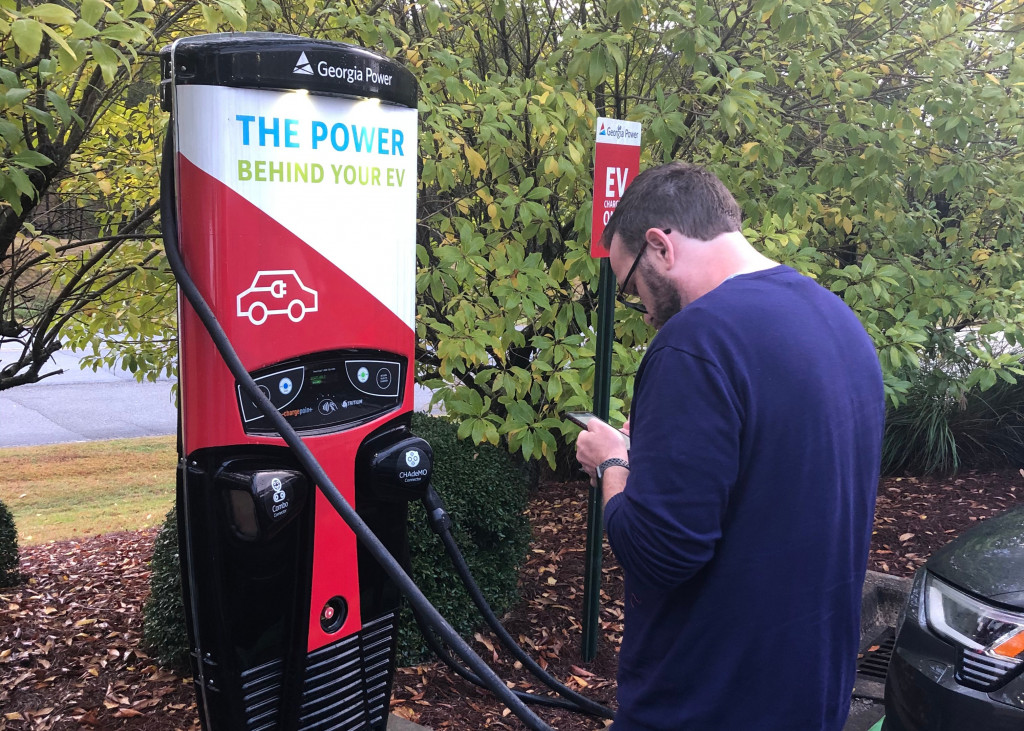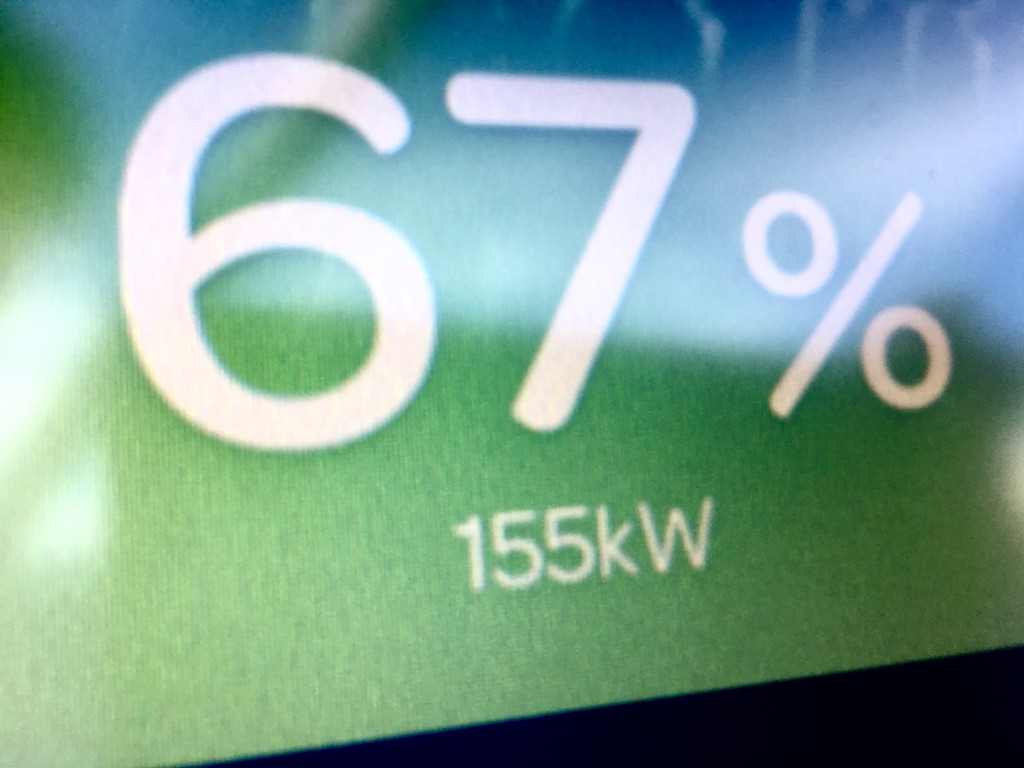East Ellijay, Georgia, might be considered part of the outermost exurbs north of metro Atlanta, or a gateway to the foothills of the Blue Ridge Mountains, where in October Internet Brands Automotive editors rounded up the cohort of Best Car To Buy nominees for Green Car Reports, Motor Authority, and The Car Connection.
A charging station there was going to be our jumping point, as a hub of activity for our Best Car To Buy Testing; instead it gave us a sample of how frustrating electric-vehicle charging infrastructure today still can be.
With GCR requiring either medium- or long-range EVs (more than 125 miles EPA-rated range) or plug-in hybrids with the electric-only range for average U.S. commutes (32 miles or more, EPA-rated), the list of contenders this year was cut to just three—the Audi E-Tron, the Kia Niro EV, and the Porsche Taycan.
Porsche wasn’t yet able to get us a Taycan in October, but with half or more of our editors getting seat time, we kept the Taycan in the running. We relied on routes around Blue Ridge to get our other editors time in the other two models—time that could efficiently involve several good driving loops in combination with periodic stops at a 50-kw ChargePoint CCS DC fast charger in East Ellijay.
Leading up to our visit we’d checked the station’s status via ChargePoint and PlugShare, and we saw no downtime.

DC fast charger, East Ellijay GA
The first morning of testing, we’d planned to drive to breakfast and charge the Audi while we ate—but within a moment we realized the whole plan for testing was going to be upended when the station failed to start and threw an error code.
The charging hardware invited us, with its dot-matrix display, to plug in and try again, so our crew tried two more times—with ChargePoint telling us the hardware appeared functional and no remote reset was possible.

ChargePoint DC fast charger, East Ellijay GA
Act One: The Scramble
Editorial director Marty Padgett summed up the dilemma: “Ellijay has the only fast charging within a 45-minute radius of our test home, and without that capability, we would have to make Solomon's choice when it came to range: Use it up getting to a fast-charger and then using most of that again on the way back, or trickle-charging since our 240V outlet in the cabin wasn't the correct plug type.”
That’s right. We DID have a 240V outlet at the cabin—in reach of where we could pull up the cars. But it was a 6-50 socket, not the 14-50 required by the E-Tron’s mobile charge point (and more likely, based on previous experience with rentals). To compound the tease, there’s no easy solution to this to be found at any Home Depot, and a local electrical and appliance shop told us that we’d be better off just installing a 14-50 (ten bucks of parts and a half hour of labor) than trying to find an adapter. We were tempted—but as renters we really couldn’t go there.

Audi E-Tron mobile charger
I got working on getting some charge back in the Niro EV while my colleagues worked on the E-Tron. PlugShare pointed to a Level 2 charger at the Blue Ridge Inn Bed & Breakfast, in downtown Blue Ridge—where the ChargePoint-branded Level 2 charger wasn’t working. The Tesla Destination Charger was, however, and inn owner Gene Holcombe helped us plug in with a big, expensive adapter—one that seemed to reduce our charging speeds versus typical Level 2 hardware, giving us less than 20 percent of additional charge (and a mildly concerning amount of heat, it seemed) in nearly 2.5 hours.
Act Two: Make-your-own charging station
Meanwhile my colleagues couldn’t find any other nearby charging where we could leave vehicles plugged in for hours on end, so they resorted to contacting a local electric vehicle group and got a suggestion: rent a campsite.
That’s what we did, paying $45 a night for a nearby RV site with a NEMA 14-50 socket running on what was said to be a 50-amp circuit.
As I headed over to join them, I noticed that the ChargePoint app was still indicating the charger as up and functional, so I called ChargePoint to check on it. The tech told me that he did see three failed charging attempts earlier in the morning—the only attempts that day—and the record of my colleagues reporting the equipment. He confirmed that the issue had been reported to the site’s owner.

ChargePoint DC fast charger in East Ellijay GA
I asked again why it wasn’t displayed as out of service. He said that it won’t be shown as needing maintenance until a ChargePoint tech has verified onsite that it’s down.
Here’s where it gets even more frustrating: The tech said no person from ChargePoint will be sent out to address the issue, as ChargePoint techs aren’t dispatched until the hardware owner verifies that there is a fault. This hardware was owned by Georgia Power, who hadn’t yet acknowledged the report of the issue to ChargePoint, hours later.
We reached out to ChargePoint, and the company outlined that stations on its network are pinged every 10 minutes to determine their status. In this case, the issue was related to the CCS port, while the CHAdeMO port at the same unit was still fully functional.
“ChargePoint is continually refining processes and enhancing our solutions to ensure that we are as precise possible across all of our solutions and use cases,” said spokesman Daryll Harrison. “One of the many benefits of a smart and connected solution is that we are able to understand how different situations affected driver experience and make software changes to ensure that experiences continues to improve.”
Some takeaways
2019 was the long-awaited year in which many charging networks bonded together with something resembling roaming agreements among cellphone networks—the ability to take your billing information along when you travel to charging hardware that’s on another network.
That’s useful, but it amounts to smoke and mirrors. With Tesla Supercharging, for instance, the hardware is actually owned by the same company collecting the revenue—and it’s in their interest to clear errors quickly and solve hardware issues.
“What I remember mostly was the sense of doom, aka, we can't even drive short loops with this thing,” said Padgett, when I asked for more feedback about the experience.
In retrospect, however, the light number of check-ins shouldn’t have made us so confident.
Act Three: Care and feeding
Finally with a system set for keeping these vehicles charged, we homed in on the area’s combination of beautiful driving roads, fair weather, colorful leafy photo backdrops, and remarkably little midweek traffic.
We quickly came to grips with the set of nuanced barriers that each of these vehicles had. Luckily they both had excellent range meters—meters that in the case of the E-Tron seemed fluid and slightly pessimistic (a good thing in an EV) and in the case of the Niro EV tended to make minor adjustments in steps but seemed entirely predictable.
In testing, keeping the E-Tron’s big 95-kwh battery filled proved to be the biggest hurdle in this situation, as its included mobile charger was only charging at a rate of about 16 hours for a full charge. And in what shaped up to be a case of user error, we found out later that it had been running in its reduced 20-amp mode, and holding a side button down for several seconds would have enabled the full 40 amps.

2019 Kia Niro EV
The Niro EV has a built-in advantage because of its smaller battery and better efficiency (amounting to a longer overall range), but both models can charge on Level 2 in about the same time (roughly 9 hours), because of the Niro EV’s 7.2-kw onboard charger and the E-Tron’s 9.6-kw one.
Although the Niro EV was picked up from us and we didn’t get a refresher on how it does on functional DC fast charging, the drive back to Atlanta with the E-Tron was flawless. I covered 76.6 miles from Blue Ridge to the Electrify America station in Marietta, during which the trip meter moved our estimated range from 134 miles to 67 miles (a 67-mile difference). And then it took just 15 minutes to cram nearly 37 kwh back into the E-Tron, bringing it from 31 to 72 percent.

Charging at Electrify America, Marietta GA

E-Tron at 350-kw fast charger

E-Tron at 350-kw fast charger
If only we had fast-charging hardware even half as fast as that in places farther off the Interstate—in tourist locales like Blue Ridge, where the clean air and quiet of electric motoring are perhaps best enjoyed.
That day will come—just maybe not soon enough.













